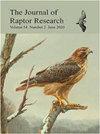Conspecific Carcass Removal from a Wind Project Study Plot by a Great Horned Owl (Bubo virginianus)
IF 1.2
4区 生物学
Q2 ORNITHOLOGY
引用次数: 0
Abstract
Assessing impacts of wind farms on volant animals requires conducting fatality monitoring studies that incorporate integrated carcass detection trials to account for searcher detection probability and carcass persistence and to reduce biases in the estimated number of fatalities (Smallwood et al. 2018). These trials involve placing a wide range of volant animal carcasses that mimic the expected species composition and actual spatial and temporal patterns of fatalities deposited by the wind turbines and measuring rates of carcass detection (Smallwood et al. 2018). When combined with remote cameras, carcass placement trials can reveal the suite of local scavengers that affect carcass persistence. We report here on an incident of conspecific carcass removal by a Great Horned Owl (Bubo virginianus) documented during a study designed to assess scavenger removal rates of avian carcasses at a wind energy project (Smallwood et al. 2009, 2010). We conducted the scavenger removal study from 12 December 2006 to 28 September 2007 on a 250ha parcel of land administered by the East Bay Regional Park District in the Altamont Pass Wind Resource Area, California, USA. The study area contained 52 functional wind turbines situated in rows along ridgelines within a landscape dominated by annual grasses. Sixty-three avian carcasses representing diverse avian species and body sizes, including two Great Horned Owls, were used for this study. Carcasses were obtained fresh-dead as either road kills or from animal rehabilitation hospitals and were kept frozen until used. To avoid scavenger swamping, from one to five carcasses were placed each week at randomly chosen locations within 60-m radii of wind turbine bases throughout the facility. Infrared, motion-activated cameras (Reconyxt, Holmen, WI, USA) were attached to metal posts approximately 1 m above the ground and 1.5 m away from each carcass. When activated, the cameras were set to take five pictures in rapid succession, with a recovery phase of approximately 1 sec between firings. All scavenging trial locations were monitored with cameras for 21 d after carcass placement or until a carcass was removed by scavengers, whichever came first. In some instances, camera removals were delayed beyond 21 d due to field conditions. After cameras were removed, all trial locations with either partial carcasses or feathers continued to be monitored weekly by biologists until the end of the study. For more details on this study, see Smallwood et al. (2009). A Great Horned Owl carcass was placed on 19 December 2006 at 1500 H in front of a remote camera set-up. On 13 January 2007, at 1843 H, a Great Horned Owl was photographed landing on大角猫头鹰(Bubo virginianus)从风力工程研究地块移除同种尸体
评估风电场对流浪动物的影响需要进行死亡率监测研究,其中包括综合尸体检测试验,以考虑搜索者发现概率和尸体持久性,并减少估计死亡人数的偏差(Smallwood et al. 2018)。这些试验包括放置各种挥发性动物尸体,模拟预期的物种组成和风力涡轮机沉积的实际死亡时空模式,并测量尸体检测率(Smallwood等人,2018)。当与远程摄像机相结合时,尸体放置试验可以揭示影响尸体持久性的当地食腐动物。我们在此报告了一项研究中记录的大角猫头鹰(Bubo virginianus)清除同种尸体的事件,该研究旨在评估风能项目中鸟类尸体的清除率(Smallwood et al. 2009, 2010)。我们于2006年12月12日至2007年9月28日在美国加利福尼亚州Altamont Pass风力资源区东湾地区公园区管理的一块250公顷的土地上进行了清除研究。研究区域包含52个功能风力涡轮机,沿山脊线排列,在一年生草为主的景观中。这项研究使用了63具鸟类尸体,代表了不同的鸟类种类和体型,其中包括两只大角猫头鹰。尸体是从新鲜的道路死亡或动物康复医院获得的,并冷冻保存直到使用。为了避免食腐动物淹没,每周将一到五具尸体随机放置在整个设施内风力涡轮机基地半径60米范围内的位置。红外运动激活摄像机(Reconyxt, Holmen, WI, USA)安装在距地面约1米,距每具尸体1.5米的金属柱子上。激活后,相机被设置为快速连续拍摄五张照片,每次拍摄之间的恢复阶段约为1秒。在屠体放置后或直至屠体被食腐动物移走之前,以先到者为准,用摄像机监测所有食腐动物试验地点21 d。在某些情况下,由于现场条件的原因,相机的移除被推迟到21天以后。在移除摄像机后,生物学家继续每周监测所有有部分尸体或羽毛的试验地点,直到研究结束。关于这项研究的更多细节,请参见Smallwood et al.(2009)。2006年12月19日下午15时,一只大角猫头鹰的尸体被放置在远程摄像机前。2007年1月13日,1843时,一只大角猫头鹰被拍到降落在
本文章由计算机程序翻译,如有差异,请以英文原文为准。
求助全文
约1分钟内获得全文
求助全文
来源期刊

Journal of Raptor Research
生物-鸟类学
CiteScore
2.30
自引率
17.60%
发文量
61
审稿时长
>12 weeks
期刊介绍:
The Journal of Raptor Research (JRR) is an international scientific journal dedicated entirely to the dissemination of information about birds of prey. Established in 1967, JRR has published peer-reviewed research on raptor ecology, behavior, life history, conservation, and techniques. JRR is available quarterly to members in electronic and paper format.
 求助内容:
求助内容: 应助结果提醒方式:
应助结果提醒方式:


